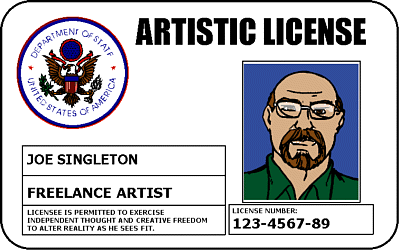|
You know that saying, "there's one in every family?" Well, it seems to be
true of the gods, as well. In almost every pantheon, there is one god
mischief, a trickster. Usually, he's got a real dark side, too, but
sometimes he manages to save everyone. Often, his irresponsible actions, his
tricks, or pranks have fortuitous results. As much as they hate the bucket
of slops falling from over the door, or the occasionaly act of infidelity,
they can't get by without him. This is no less true in the Norse tradition.
He's called "the Father of Monsters," because a few of his offspring are a
bit on the scary side. He and his children figure prominently in the end of
the world, in the Norse tradition, when he will fight against the gods, on
the side of the giants. Blood is thicker than water.
One story goes that Loki was a foundling, that Odin found a child on the
battlefield, (small for a giant's child) after a skirmish with a group of
giants. He took the "god-size" child into his own home, to raise as a son.
Being raised alongside Odin's most favored son, Thor, it should not be
surprising that there should be some rivalry, between the two. More than
once, Loki's actions would bring the wrath of the gods, down on his head,
after which he would have to find some way to appease them.
Naturally, when Marvel Comics added Thor to their growing collection of
heroes, in the '60s, Loki was a perfect villain. In mythology, one of Loki's
pranks led to the creation of the treasures of the gods, Thor's hammer
Mjolnir, Odin's spear Gungnir and others. In Marvel history, Loki's actions
led to the creation of the Avengers, without whom the world might never have
survived.

Loki's original costume, shows Jack Kirby's aesthetic, fairly simple, but
with those horns, it's unmistakably Kirby. And, uh, yellow and green, the
god of nausea?
One of the major themes in Norse mythology is an almost appressive
fatalism. Odin hanged himself from the Yggdrasil, the World Tree, for nine d
ays and sacrificed an eye, to gain a vision of the future. This future was
immutable, every action fore-ordained, every life and death, until the day
the reckoning, the final battle between the giants and the gods, Ragnarok.
You can see why Odin might not be the life of the party, but you can also
see why he might tend to overlook Loki's various trespasses against the
Aesir. He's seen it, he knows every scheme, every prank, every piece of
mischief, every world-beating plan that Loki will come up with. He knows
whether they succeed or fail, and he knows, in the end, none of it matters.
I think this is what happens when an entire culture develops in a climate
where, for 5 or 6 months of the year, the sun never comes up, a society
afflicted with seasonal affective disorder, possibly. The cold, the damp,
the darkness . . . it's no surprise these people came up with a morose and
fatalistic religion.
Of course, Loki does not have Odin's foreknowledge, he is forced to play
out his schemes, whether or not they have any chance of ultimate success.
In the 1980s, Thor went through a bit of a renaissance, as a title. Walt
Simonson came in like a storm, with his unique art and writing style and his
unmatched sense of humor. Simonson breathed new life into a floundering
title. His love of Norse mythology let him take Thor in a new direction,
even eliminating Thor's secret identity, the lame doctor, Donald Blake and
intruducing a new Thunderer, the alien cyborg Beta Ray Bill. Simonson also
revised Loki's attire, giving him a more "regal" look. He still wore yellow
and green, as he did before, but it's definitely an improvement.

I like the overall look, but the circular cutouts seem a bit strange.
Still, it'd be nice if the colors could change, but it's too late for that,
now.
For my design, I tried to keep some of he lines of Simonson's design, keep
that "regal" element, but remove some of the unwieldy bits, the giant horns,
the sharp-cornered bits. While Loki tends to get his way through guile, he's
still a warrior of Asgard, no matter which side he's destined to end up on,
hence the sword and spear, the barbuta-style helm with the stylized dragon
wings, and the armored pieces. As I said, it's too late to change the
colors, but I decided on less garish shades, the advantages of computer
coloring and modern printing techniques. We have more colors to play with,
and the ability to consistently reproduce them.

Prankster, trickster, god of mischief, father of monsters and eventual
betrayer of Asgard. Loki's not exactly a devil, but he's certainly no saint.
Of all the mythological pantheons, the Norse gods were among the most human.
Maybe that's why they're so appealing to readers.
See you next month.
|




